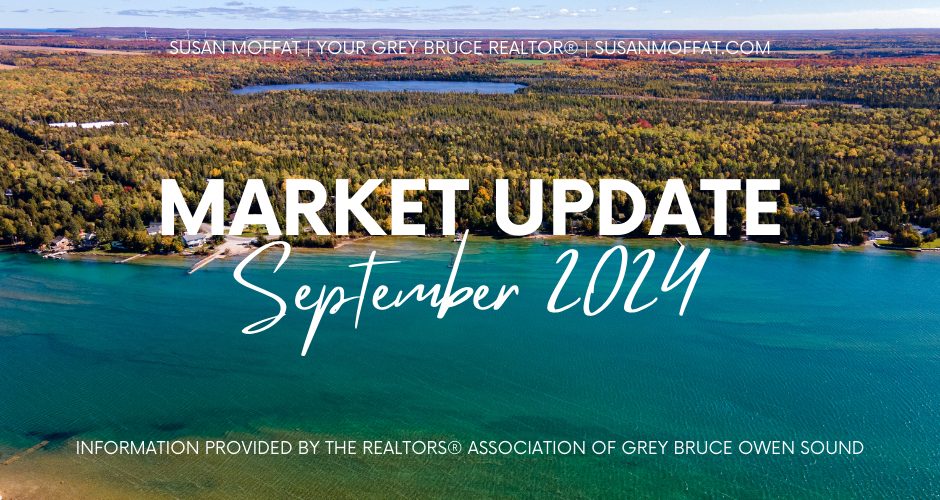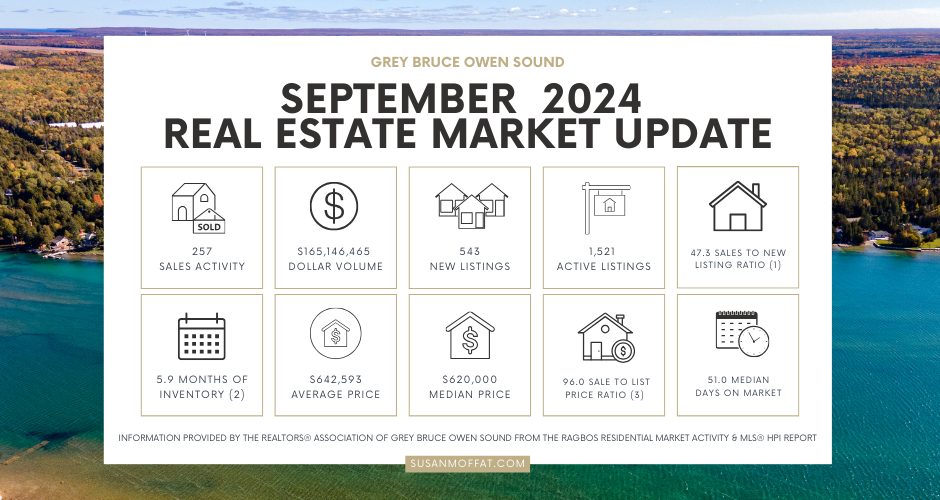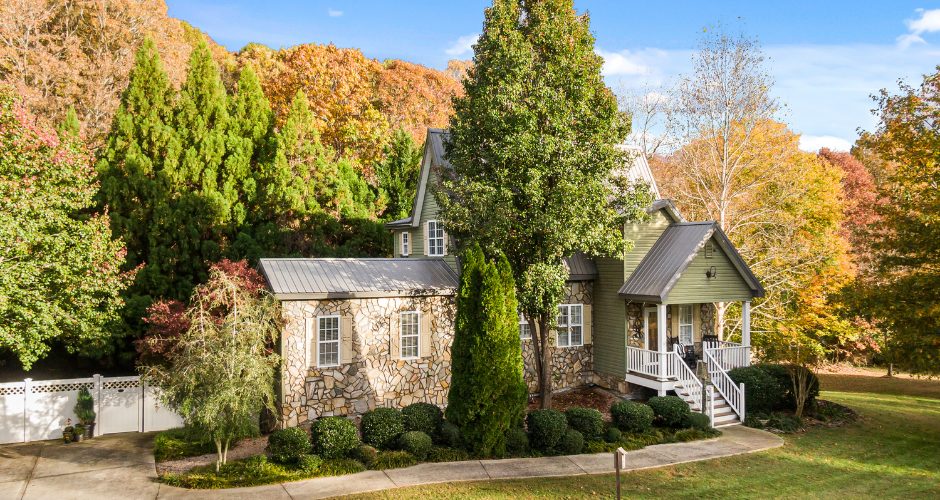Social Links Widget
Click here to edit the Social Media Links settings. This text will not be visible on the front end.
September 2024 Real Estate Market Update

REALTORS® Association of Grey Bruce Owen Sound reports MLS® home sales surge in September.
The number of homes sold through the MLS® System of the REALTORS® Association of Grey Bruce Owen Sound totaled 257 units in September 2024. This was a jump of 42.8% from September 2023.
Home sales were 5% below the five-year average and 11.5% below the 10-year average for the month of September.
On a year-to-date basis, home sales totaled 1,987 units over the first nine months of the year. This increased by 1% from the same period in 2023.
The MLS® Home Price Index (HPI) tracks price trends far more accurately than is possible using average or median price measures. The overall MLS® HPI composite benchmark price was $573,800 in September 2024, falling by 1.8% compared to September 2023.
The benchmark price for single-family homes was $582,100, a modest decline of 2% on a year-over-year basis in September. By comparison, the benchmark price for townhouse/row units was $489,100, nearly unchanged, up only 0.3% compared to a year earlier, while the benchmark apartment price was $377,700, a minor increase of 3.9% from year-ago levels.
The average price of homes sold in September 2024 was $642,593, a modest decline of 1.5% from September 2023. The more comprehensive year-to-date average price was $645,441, up modestly by 1.7% from the first nine months of 2023. The dollar value of all home sales in September 2024 was $165.1 million, a substantial increase of 40.6% from the same month in 2023.
The number of new listings saw a moderate gain of 9.5% from September 2023. There were 543 new residential listings in September 2024. This was the largest number of new listings added in the month of September in more than three decades. New listings were 18.7% above the five-year average and 29% above the 10-year average for the month of September.
Active residential listings numbered 1,521 units on the market at the end of September, increasing by 17.4% from the end of September 2023. Active listings haven’t been this high in the month of September in more than five years. Active listings were 49.7% above the five-year average and 26.3% above the 10-year average for the month of September.
Months of inventory numbered 5.9 at the end of September 2024, down from the 7.2 months recorded at the end of September 2023 and above the long-run average of 4.4 months for this time of year. The number of months of inventory is the number of months it would take to sell current inventories at the current rate of sales activity.

(1) Sales / new listings * 100; compared to levels from previous periods.
(2) Active listings at month end / monthly sales; compared to levels from previous periods.
(3) Sale price / list price * 100; average for all homes sold in the current month.
Board & Association Information
The REALTORS® Association of Grey Bruce Owen Sound represents approximately 450 REALTORS® registered with its member offices. The geographical area served by the Association is in southwestern Ontario, bordered by Lake Huron and Georgian Bay including Bruce and Grey Counties, and part of Wellington County.
Related: August 2024 Real Estate Market Update
Wondering how these numbers might impact your real estate plans? Whether you’re buying, selling, or just curious about market trends, I’ve got you covered! Let’s navigate the market together! Contact me for a complimentary, no-obligation property valuation!
For more information, contact:
Susan Moffat, REALTOR® with Century 21 In-Studio Realty Inc., Brokerage
519.377.5154
susan.moffat@c21.ca
Showing Ready: Essential Items to Put Away for Home Showings

Preparing your home for showings is essential for making a great first impression on potential buyers. Here’s a tailored guide on what to put away during showings to ensure your home looks its best:
Personal Items
- Family Photos: Remove personal photographs and artwork that showcase your family life. This helps buyers imagine themselves in the space without distractions.
- Valuables: Secure any valuable items, including jewelry, important documents, and personal electronics like laptops, to prevent theft and maintain privacy.
- Medications: Keep prescription medications out of sight to ensure a safe environment for visitors.
Everyday Items
- Clutter: Clear surfaces of everyday items like mail, keys, and shoes. A tidy space appears larger and more inviting.
- Pet Supplies: If you have pets, remove their bowls, toys, and litter boxes. This not only keeps the space clean but also avoids any distractions for potential buyers.
- Laundry: Ensure that all laundry is put away, including items hanging to dry and any clothes left on the floor.
Kitchen and Dining Areas
- Countertop Appliances: Store away small appliances like toasters and coffee makers to maximize counter space and create a clean look.
- Dish Racks: Remove any visible dish drying racks or sponges from the sink area.
- Refrigerator Magnets: Clear the refrigerator of magnets, notes, and photos for a streamlined appearance.
Bedrooms and Bathrooms
- Personal Care Items: Remove toiletries and personal items from countertops in bathrooms and bedrooms. This includes deodorants, lotions, and hair products.
- Clothing: Ensure all clothing is neatly stored in closets or dressers, with nothing visible on floors or furniture.
Final Touches
- Trash Bins: Empty all trash bins throughout the house to maintain cleanliness.
- Remote Controls: Neatly arrange or store away TV remotes and other electronic controls to reduce clutter.
- Lighting and Ambiance: Ensure all lights are on and windows are open to let in natural light, creating a warm and inviting atmosphere.
Final Thoughts
By following these steps, you can create a welcoming environment that highlights your home’s best features, making it more appealing to potential buyers. A well-prepared home not only enhances its attractiveness but also increases the likelihood of a successful sale. Check out this article from Apartment Therapy with lots of tips about decluttering.
Looking to buy, sell, or invest? As your REALTOR®, I’ll guide you every step of the way. Contact me today and let’s turn your real estate dreams into reality!
For more information, contact:
Susan Moffat, REALTOR® with Century 21 In-Studio Realty Inc., Brokerage
519.377.5154
susan.moffat@c21.ca
Household Fire Prevention 101

October is Fire Prevention Month, a time to reflect on the importance of fire safety and to take proactive measures to protect our homes and loved ones. It’s essential to regularly review key fire prevention strategies that can significantly reduce the risk of devastating fires in your home. Here are some critical reminders to keep your living space safe.
Ensure Working Smoke Alarms
The most effective way to safeguard your home is by installing working smoke alarms. Here’s how to ensure they function correctly:
- Install smoke alarms on every level of your home, including inside bedrooms and outside sleeping areas.
- Test alarms monthly by pushing the test button to ensure they are operational.
- Change batteries at least twice a year, ideally during daylight saving time changes.
- Replace smoke alarms every 10 years, or sooner if they do not respond when tested.
Statistics show that nearly three out of five fire deaths occur in homes without working smoke alarms, highlighting their critical role in fire safety .
Practice Safe Cooking Habits
Cooking is a leading cause of home fires, so practicing safe cooking habits is vital:
- Never leave cooking unattended. If you must leave the kitchen, turn off the stove.
- Keep flammable items like dish towels and packaging away from heat sources.
- Use timers to remind you when food is cooking, especially for simmering or baking.
In case of a small grease fire, remember to smother it with a lid or use a fire extinguisher if safe to do so. If the fire escalates, evacuate immediately and call emergency services .
Maintain Heating Equipment
As temperatures drop, heating systems become essential but can also pose fire risks:
- Keep heaters away from flammable materials such as curtains and furniture.
- Have your heating system serviced regularly, including chimneys if applicable, to prevent buildup that could ignite.
- Use screens for fireplaces to contain sparks and embers.
Regular maintenance can help ensure that your heating systems operate safely throughout the colder months .
Electrical Safety
Electrical issues are another common cause of house fires. To minimize risks:
- Inspect electrical cords for damage and replace any that are frayed or worn.
- Avoid overloading outlets. Use power strips with surge protectors and plug only light-load appliances into them.
- Unplug appliances when not in use to prevent overheating.
Candle and Open Flame Safety
Candles can create a cozy atmosphere but also pose significant fire hazards:
- Never leave candles unattended. Always extinguish them before leaving a room or going to bed.
- Use sturdy candle holders that won’t tip over easily and keep them away from flammable materials.
- For fireplaces, ensure embers are completely extinguished before leaving the area.
Regular Maintenance Checklist
To keep your home safe from fires, consider this maintenance checklist:
- Test smoke alarms monthly and change batteries biannually.
- Keep an eye on cooking appliances; never leave them unattended.
- Schedule annual inspections for heating systems and clean dryer vents regularly.
- Replace damaged electrical cords immediately and avoid overloading outlets.
- Review your fire escape plan with your household at least once a year. Ensure everyone knows their escape routes and the designated meeting spot outside. Practice the plan so that everyone feels confident in case of an emergency.
Final Thoughts

By staying vigilant and proactive about fire safety, you can protect your home and loved ones from potential tragedies. Fire Prevention Month serves as a crucial reminder to take these steps seriously—not just in October but throughout the entire year. Find more resources on public safety from the Ontario Association of Fire Chiefs.
Looking to buy, sell, or invest? As your REALTOR®, I’ll guide you every step of the way. Contact me today and let’s turn your real estate dreams into reality!
For more information, contact:
Susan Moffat, REALTOR® with Century 21 In-Studio Realty Inc., Brokerage
519.377.5154
susan.moffat@c21.ca
How to Ready Your Home for Fall: Interior & Exterior Tips for a Great Season

It’s essential to prepare your home for the seasonal transition from Summer to Autumn. This preparation not only enhances comfort but also protects your property from the challenges posed by colder weather. Here are some effective strategies to ensure your home is ready for fall.
Declutter and Clean
Start the season by thoroughly cleaning your home. Dust surfaces, vacuum carpets, scrub floors, and wash windows. This is also an ideal time to declutter; store away summer items and organize living spaces.
Additionally, focus on outdoor maintenance by cleaning out gutters to prevent clogs from falling leaves. If necessary, hire a professional to ensure this task is done safely and effectively.
Weatherproof Your Home
To maintain warmth during the cooler months, inspect and seal any gaps or cracks around windows and doors. Use caulking or weatherstripping to prevent drafts, which can significantly impact heating efficiency and comfort levels.
Check Heating Systems
Before the temperature drops, ensure your heating system is functioning optimally. Schedule a professional inspection of your furnace or heating system and replace air filters as needed. Installing a programmable thermostat can help manage indoor temperatures more efficiently.
Enhance Indoor Comfort
As the days grow shorter and cooler, it’s time to bring out cozy decor. Swap lightweight summer fabrics for heavier blankets and cushions in warm colours. Incorporate seasonal decorations like pumpkins and wreaths to create a welcoming atmosphere.
For an added sensory experience, consider using scented candles or essential oil diffusers with autumn fragrances such as cinnamon and vanilla.
Outdoor Maintenance
Prepare your outdoor spaces by trimming overgrown trees and bushes, raking leaves, and storing outdoor furniture. If you enjoy gardening, consider planting fall-blooming flowers or seasonal vegetables to keep your garden vibrant.
Additional Tips
- Inspect Your Roof: Look for loose or damaged shingles and make necessary repairs to prevent leaks during winter storms.
- Lawn Care: Aerate your lawn and overseed it to promote healthy growth for the next spring.
- Chimney Cleaning: If you have a fireplace, ensure that it is cleaned and inspected for safe use throughout the colder months.
Final Thoughts: Enjoying the Season in Comfort and Style
By following these steps, you can create a warm, inviting environment in your home while ensuring it is well-prepared for the challenges of autumn in Grey Bruce. Embrace the beauty of the season with a cozy, comfortable space that reflects the charm of fall!
Looking to buy, sell, or invest? As your REALTOR®, I’ll guide you every step of the way. Contact me today and let’s turn your real estate dreams into reality!
For more information, contact:
Susan Moffat, REALTOR® with Century 21 In-Studio Realty Inc., Brokerage
519.377.5154
susan.moffat@c21.ca
When to Consider Buying a “Diamond in the Rough”

Let’s face it. When you visit a home during a scheduled viewing or open house, you’re usually seeing it at its best. The rooms are tidy. The sinks are clean. The closets are organized and uncluttered. Even the lighting is set to its brightest.
That’s just good old-fashioned marketing.
However, not every house you see will actually look this way. For any number of reasons, a house on the market may be less than tidy, poorly decorated, and even in need of minor repairs. You may open the front door in anticipation, only to be immediately turned off by stains on the carpets, faded paint on the walls, cluttered hallways, and more.
First impressions form quickly. It’s easy to make quick judgments and move on. But, you may be passing on what could be a dream home. Don’t make that mistake. Make your purchase decision based on a carefully considered second impression, not just your first. When viewing a house, imagine how it will look with a fresh coat of paint, some redecorating, the minor repairs completed, and your furniture adorning the rooms. You might just find that a home that doesn’t show well is really a diamond in the rough.
(One caveat: Be careful of houses that don’t look like they’ve been well maintained. There could be issues lurking that may require expensive repairs or renovations. Always make a professional home inspection a condition of your offer.)
There are advantages to buying a home that doesn’t show well. They attract less interest and, therefore, less competition from other potential buyers.
Looking to buy, sell, or invest? As your REALTOR®, I’ll guide you every step of the way. Contact me today and let’s turn your real estate dreams into reality!
For more information, contact:
Susan Moffat, REALTOR® with Century 21 In-Studio Realty Inc., Brokerage
519.377.5154
susan.moffat@c21.ca
August 2024 Real Estate Market Update

REALTORS® Association of Grey Bruce Owen Sound MLS® home sales continue to show signs of picking up in August.
The number of homes sold through the MLS® System of the REALTORS® Association of Grey Bruce Owen Sound totaled 236 units in August 2024. This was an increase of 7.8% from August 2023.
Home sales were 14.9% below the five-year average and 23.6% below the 10-year average for the month of August.
On a year-to-date basis, home sales totaled 1,721 units over the first eight months of the year. This was a small reduction of 3.3% from the same period in 2023.
The MLS® Home Price Index (HPI) tracks price trends far more accurately than is possible using average or median price measures. The overall MLS® HPI composite benchmark price was $582,200 in August 2024, essentially unchanged, down just 0.2% compared to August 2023.
The benchmark price for single-family homes was $591,200, a slight reduction of 0.3% on a year-over-year basis in August. By comparison, the benchmark price for townhouse/row units was $473,200, edging down 0.8% compared to a year earlier, while the benchmark apartment price was $384,500, a gain of 4.9% from year-ago levels.
The average price of homes sold in August 2024 was $645,294, increasing by 4.9% from August 2023. The more comprehensive year-to-date average price was $645,371, a modest gain of 2.1% from the first eight months of 2023. The dollar value of all home sales in August 2024 was $152.3 million, up by 13% from the same month in 2023.
The number of new listings saw an increase of 5.6% from August 2023. There were 471 new residential listings in August 2024. This was the largest number of new listings added in the month of August in more than five years.
New listings were 13.2% above the five-year average and 14.5% above the 10-year average for the month of August.
Active residential listings numbered 1,398 units on the market at the end of August, a sizable gain of 12.3% from the end of August 2023. Active listings haven’t been this high in the month of August in more than five years. Active listings were 39.8% above the five-year average and 11.4% above the 10-year average for the month of August.
Months of inventory numbered 5.9 at the end of August 2024, up from the 5.7 months recorded at the end of August 2023 and above the long-run average of 4.3 months for this time of year. The number of months of inventory is the number of months it would take to sell current inventories at the current rate of sales activity.

1) Sales / new listings * 100; compared to levels from previous periods. (2) Active listings at month end / monthly sales; compared to levels from previous periods. (3) Sale price / list price * 100; average for all homes sold in the current month.
Board & Association Information
The REALTORS® Association of Grey Bruce Owen Sound represents approximately 450 REALTORS® registered with its member offices. The geographical area served by the Association is in southwestern Ontario, bordered by Lake Huron and Georgian Bay including Bruce and Grey Counties, and part of Wellington County.
Related: July 2024 Real Estate Market Update
Wondering how these numbers might impact your real estate plans? Whether you’re buying, selling, or just curious about market trends, I’ve got you covered! Let’s navigate the market together! Contact me for a complimentary, no-obligation property valuation!
For more information, contact:
Susan Moffat, REALTOR® with Century 21 In-Studio Realty Inc., Brokerage
519.377.5154
susan.moffat@c21.ca
Choosing the Right Real Estate Lawyer

When buying or selling a property, having a skilled real estate lawyer by your side is crucial. The right professional can help navigate complex legal issues, protect your interests, and ensure a smooth transaction. Here’s how to choose the best real estate lawyer for your needs:
Start Your Search Early
Begin looking for a lawyer as soon as you decide to buy or sell property. This gives you ample time to research and find the right fit without feeling rushed. If you’ve worked with a real estate lawyer before and had a positive experience, consider rehiring them.
Seek Recommendations
Ask friends, family, or colleagues who have recently bought or sold property for lawyer recommendations. As a REALTOR®, I regularly work with real estate lawyers on transactions and can recommend a trusted local lawyer who specializes in real estate law.
Look for Specialized Experience
It’s critical to hire a lawyer who specializes in real estate law and frequently handles property transactions. The right lawyer will be familiar with local laws and regulations, potentially helping you avoid costly mistakes.
Check Credentials and Reviews
Research potential lawyers online. Look for:
- Years of experience in real estate law
- Professional credentials and affiliations
- Client reviews and testimonials
- Any disciplinary actions or complaints
Many law societies and real estate boards like the Law Society of Ontario can provide information on a lawyer’s standing and reputation.
Schedule Consultations
Most real estate lawyers offer free initial consultations. Take advantage of this to meet with a few candidates. During these meetings, ask about:
- Their experience with cases similar to yours
- Their approach to handling real estate transactions
- Their availability and communication style
- Fee structure and estimated costs
Consider Compatibility
Choose a lawyer you feel comfortable working with. You’ll be sharing personal and financial information, so it’s important to feel at ease with your lawyer. Look for someone who explains things clearly and patiently answers your questions.
Understand the Fee Structure
Ask for a detailed breakdown of fees and costs. Some lawyers charge a flat fee for real estate transactions, while others bill by the hour. Make sure you understand what services are included and if there are any potential additional costs.
Verify Local Expertise
Real estate laws can vary significantly between jurisdictions. Ensure your lawyer is well-versed in the specific regulations of your area. A local lawyer will also have valuable knowledge about regional market trends and potential issues.
Check Availability
Real estate transactions often have tight deadlines. Confirm that your chosen lawyer has the capacity to handle your case in a timely manner. Ask about their typical response time and how they prefer to communicate with clients.
Trust Your Instincts
After considering all these factors, trust your judgment. If something doesn’t feel right about a particular lawyer, it’s okay to keep looking. The goal is to find a lawyer who not only has the right expertise but also makes you feel confident and supported throughout the process.
Final Thoughts: Navigating Your Real Estate Transaction with Confidence

Remember, your real estate lawyer plays a crucial role in protecting your interests during one of the most significant financial transactions of your life. By taking the time to choose the right lawyer, you can ensure a smoother, less stressful property buying or selling experience.
Looking to buy, sell, or invest? As your REALTOR®, I’ll guide you every step of the way. Contact me today and let’s turn your real estate dreams into reality!
For more information, contact:
Susan Moffat, REALTOR® with Century 21 In-Studio Realty Inc., Brokerage
519.377.5154
susan.moffat@c21.ca
Rate Announcement: How the Bank of Canada’s Decision Affects You

The Bank of Canada has announced its third consecutive interest rate cut, lowering the overnight rate target to 4.25%. This decision comes as inflation continues to moderate and economic growth shows signs of softening.
Economic Context
The Canadian economy grew by 2.1% in the second quarter, slightly stronger than anticipated. However, recent indicators suggest economic activity has slowed in June and July. The labour market is also cooling, with minimal employment changes in recent months.
Inflation has continued its downward trend, reaching 2.5% in July. While this is a positive development, the Bank of Canada remains vigilant about inflationary pressures, particularly in shelter costs and some services.
Impact on the Housing Market
This rate cut could have several implications for the real estate market:
- Mortgage Rates: With the policy rate reduction, we may see a corresponding decrease in mortgage rates. This could make homeownership more affordable for some buyers.
- Buyer Confidence: Lower interest rates may boost buyer confidence and potentially increase demand in the housing market.
- Existing Homeowners: Those with variable-rate mortgages may see a reduction in their monthly payments.
Looking Ahead
The Bank of Canada has indicated that future monetary policy decisions will be guided by incoming economic data. While further rate cuts are possible if inflation continues to ease, the central bank remains committed to its 2% inflation target.
For potential homebuyers and sellers, this rate cut presents both opportunities and considerations. It’s crucial to stay informed about market conditions and consult with real estate professionals to make well-informed decisions in this evolving economic landscape.
Remember, while interest rates play a significant role in the housing market, they are just one factor among many. Local market conditions, personal financial situations, and long-term goals should all be considered when making real estate decisions.
As your trusted Grey Bruce REALTOR®, I’m here to help you navigate these changes and find the best opportunities in our local market. Don’t hesitate to reach out if you have any questions or would like to discuss how this rate cut might affect your real estate plans.
Read the Press Release.
Looking to buy, sell, or invest? As your REALTOR®, I’ll guide you every step of the way. Contact me today and let’s turn your real estate dreams into reality!
For more information, contact:
Susan Moffat, REALTOR® with Century 21 In-Studio Realty Inc., Brokerage
519.377.5154
susan.moffat@c21.ca
Defending Your Data: Keeping Your Wi-Fi Secure

As smart technology becomes more prevalent, so too does our use of Wi-Fi, increasing our vulnerability to cyberattacks. So how do you keep your Wi-Fi secure?
- Use strong passwords (i.e., at least eight characters using upper and lowercase, numbers, and symbols, and don’t re-use passwords – use a password management software to keep track), change them regularly, and enable two-factor authentication where possible.
- Use a VPN, which encrypts your connection.
- Enable auto updates on your devices, and ensure your modem and router are updated, replacing them at least every 5 years.
- Change default modem and router passwords so no unauthorized user within signal range can access your network.
- Disable remote router access, which can leave the door open to hackers.
- Change your network name. Avoid using the default provider name or a name with personal information, which provides vulnerability clues.
- Enable a Wi-Fi guest network to segregate devices (e.g., put your computer devices on the main network and your smart devices on a guest network), limiting the scope of potential breaches.
- Enable Wi-Fi Protected Access 3 (WPA3) if available on your device, for increased data protection.
A simple online search can guide you through making the above changes if you are unsure.
Cybercrime is only expected to skyrocket in the coming years, so doing everything you can to protect your personal information will help you not become a victim.
Related: How to Quickly Improve Indoor Air Quality
Looking to buy, sell, or invest? As your REALTOR®, I’ll guide you every step of the way. Contact me today and let’s turn your real estate dreams into reality!
For more information, contact:
Susan Moffat, REALTOR® with Century 21 In-Studio Realty Inc., Brokerage
519.377.5154
susan.moffat@c21.ca
Your Moving Dilemma: To Hire Movers or Handle It Yourself?

Moving to a new home is an exciting yet challenging experience. One of the most significant decisions to make is whether to hire professional movers or to handle the move yourself. This post will explore the benefits and drawbacks of hiring movers, along with tips for a seamless moving experience.
Pros of Hiring Professional Movers

- Convenience: Professional movers manage the heavy lifting, packing, and transportation, which can save you time and effort, especially if you have a busy schedule or limited physical ability.
- Expertise: Movers are trained to handle various items, including fragile and bulky possessions, minimizing the risk of damage during transit.
- Efficiency: With the right equipment and a team, professional movers can complete the job much faster than a DIY move.
- Reduced Stress: Hiring professionals can alleviate much of the stress associated with moving, allowing you to focus on settling into your new home.
Cons of Hiring Professional Movers

- Cost: Hiring movers can be expensive, with costs varying based on distance, volume of items, and additional services like packing.
- Less Control: You may have less control over how your belongings are handled, which can be a concern for those with valuable or sentimental items.
Pros of Moving Yourself

- Cost Savings: Moving yourself can be significantly cheaper, as you save on labor costs and can choose a more affordable rental truck.
- Control: You have complete control over the packing and moving process, which is especially important for valuable items.
- Flexibility: A DIY move allows you to pack and move at your own pace, providing greater flexibility in your schedule.
Cons of Moving Yourself

- Physical Labor: Moving is physically demanding and can lead to injuries if not done carefully.
- Time-Consuming: A DIY move often takes much longer than hiring professionals, which can be challenging if you’re on a tight schedule.
- Risk of Damage: Without professional experience, there’s a higher risk of damaging belongings or property during the move.
Tips for Hiring Movers

- Get Recommendations: Ask friends and family for referrals or read online reviews to find reputable moving companies.
- Request Estimates: Create a detailed list of items to be moved to help companies provide accurate estimates. Be sure to inquire about any hidden fees.
- Check Credentials: Ensure the moving company is a member of relevant associations, such as the Canadian Association of Movers, and check their standing with the Better Business Bureau.
- Discuss Your Needs: Inform movers about any unique challenges at your current or new home, such as narrow doorways or stairs, which may affect the moving process.
- Review the Contract: Carefully read the contract to understand the services provided and any potential liabilities.
Final Thoughts on Making the Right Move

Deciding whether to hire movers or move yourself is a personal choice that hinges on your specific circumstances, including budget, time constraints, and the complexity of your move. By weighing the pros and cons and following the tips provided, you can make an informed decision that ensures a smooth transition to your new home.
Related: Moving Made Easy: Tips for a Smooth Transition with Young Children
Looking to buy, sell, or invest? As your REALTOR®, I’ll guide you every step of the way. Contact me today and let’s turn your real estate dreams into reality!
For more information, contact:
Susan Moffat, REALTOR® with Century 21 In-Studio Realty Inc., Brokerage
519.377.5154
susan.moffat@c21.ca

 Facebook
Facebook
 X
X
 Pinterest
Pinterest
 Copy Link
Copy Link
